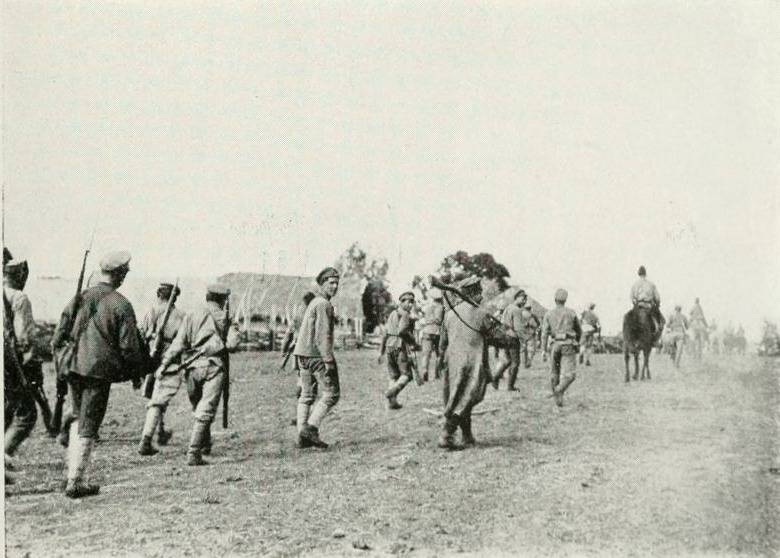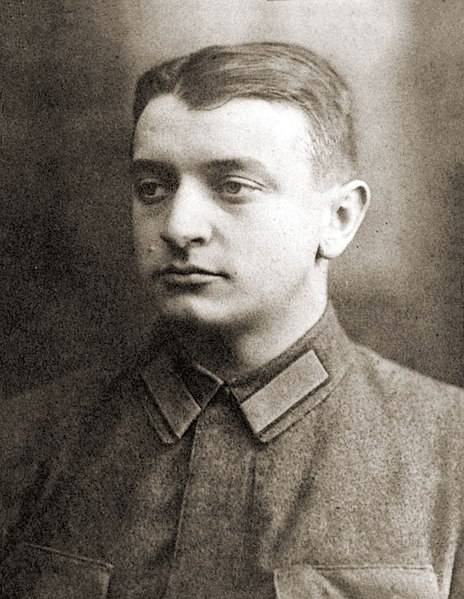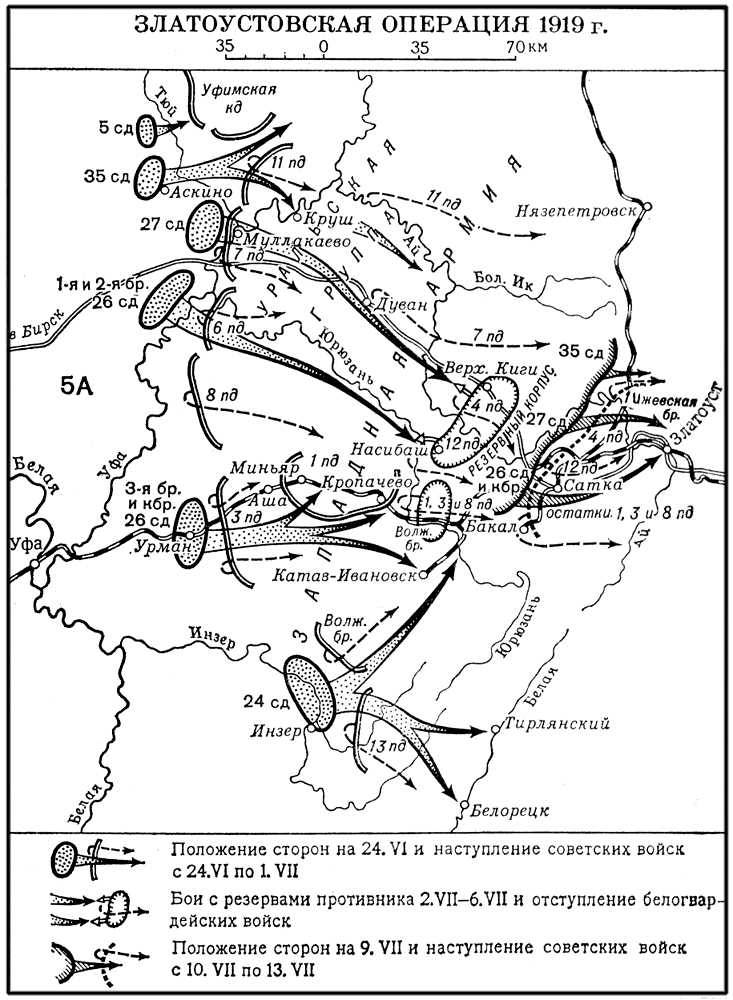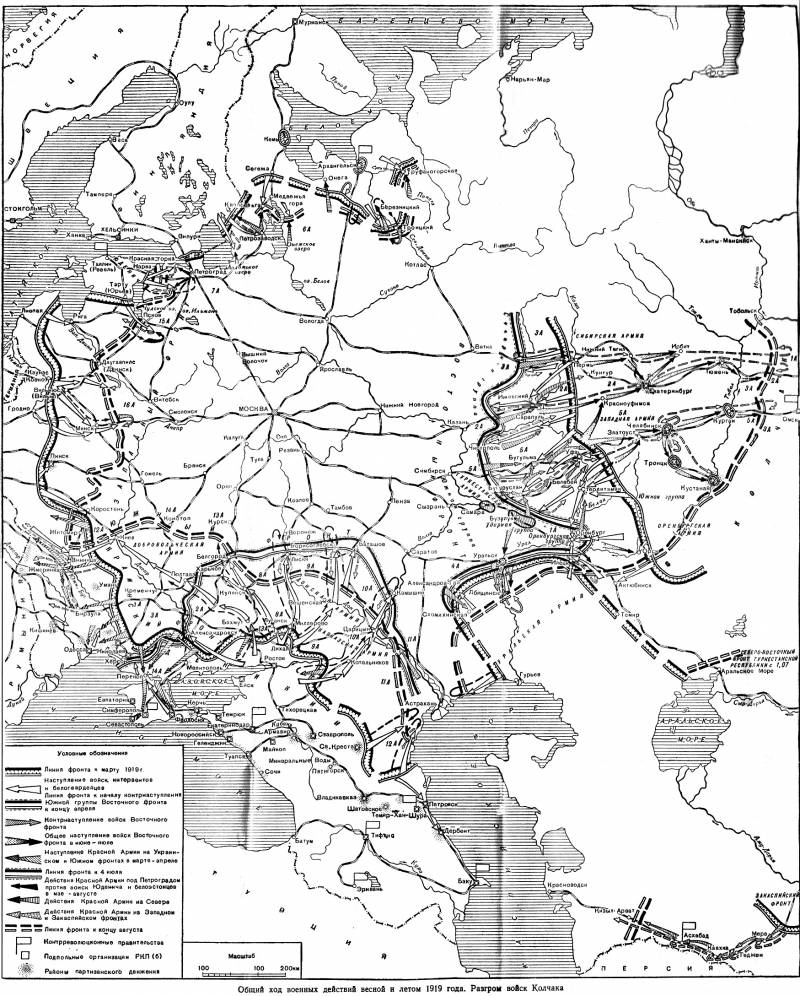Battle of the Urals

In the course of the Perm and Yekaterinburg operations, the Siberian army was defeated and the Middle Urals liberated. During the Zlatoust, Yekaterinburg and Ural operations, the Southern Urals was liberated, the Kolchak front was divided into two groups: one (1, 2, and 3 armies) - Siberia retreated, and the second (Ural and South armies) - to Turkestan.
General situation on the Eastern Front
The successful offensive of the Red Eastern Front in April — June 1919 of the year created the conditions for the complete defeat of the enemy and the liberation of the Urals. The main shock groups of the Kolchak army suffered a heavy defeat in the Ufa area (Ufa operation. How were defeated the best parts of the army of Kolchak), Kolchak units were exsanguinated, suffered heavy losses that could not be repaired. Kolchak's army lost its strategic initiative. There were no reserves to continue the struggle. The rear was falling apart. The large-scale red partisan movement in the rear of Kolchak became one of the main factors of the quick defeat of the whites.
The remnants of the Kolchak army retreated east to the Ural Mountains. After the defeat between the Volga and the Urals, the White Army in eastern Russia steadily rolled to its death. In June, the Kolchakites still avoided total annihilation of 1919, but they did not survive by their own forces, but by the attack of Yudenich’s army on Petrograd and VSYUR Denikin in southern Russia. The southern front of the Reds collapsed, whites took the Crimea, the Donbass, Kharkov and Tsaritsyn. As a result, Frunze was unable to finish off Kolchak's army, he had nothing to pursue the defeated enemy. The 2 division was transferred to Petrograd, part to Tsaritsyn, the 31 division to the Voronezh sector, the 25 division to Uralsk, the 3 cavalry division (without one brigade) to the Orenburg region.
The troops of the Eastern Front of the Red Army stopped at the turn of Orenburg - east of Sterlitamak - east of Ufa - Osa - Okhansk. Red troops recited about 130 thousand soldiers (directly at the front lines there were over 81 thousand people), 500 guns, over 2,4 thousand machine guns, 7 armored trains, 28 armored cars and 52 aircraft. They were supported by the Volga military flotilla - 27 combat and 10 auxiliary vessels. The Eastern Front in July 1919 was led by M. Frunze.
They were opposed by the troops of the Western army under the command of General Sakharov, the Siberian army under the command of Gaida, the Ural army of Tolstov, and the Southern army of Belov (the Orenburg army and the Southern group of Belov were united into one army). They numbered 129 thousand bayonets and sabers (there were about 70 thousand soldiers on the front line), 320 guns, more than 1,2 thousand machine guns, 7 armored trains, 12 armored vehicles and 15 aircraft. Kolchak's army was supported by the Kama military flotilla - an 34 armed vessel.
The Red Command planned with a strike of 5 and part of the forces of the 2 Army against Zlatoust and Chelyabinsk to smash the Western White Army and with the attack of the 2 and 3 armies against Perm and Yekaterinburg - the Siberian Army. In the areas of Orenburg and Uralsk, it was planned by active operations of the Southern Group of Forces (1-I and 4-I red armies) to constrain the actions of the enemy. The main blow of Frunze decided to inflict on the Ufa-Zlatoust direction, using the fact that the white troops here suffered the greatest losses in the May - June battles. The White command planned to actively stop the Red Army at the frontiers of the rivers Ufa and Kama by the active defense of their troops and later establish contact with the army of Denikin with the help of a strike by the Southern and Ural armies.
Attempts of the West to strengthen the army of Kolchak
The successes of the Red Army on the Eastern Front destroyed the plans of the Entente powers for the occupation and dismemberment of Russia (the so-called "reconstruction of Russia"). Therefore, in the summer of 1919, the United States, England, France and Japan tried to increase assistance to the Kolchak regime. May 26 1919, the Allied Supreme Council, in a discussion of the “Russian question” in Paris, sent Kolchak a note on the conditions for its recognition. Kolchak was promised material military assistance on the terms of convening a Constituent Assembly after the capture of Moscow; recognition of the independence of Poland and Finland; settle relations with the Baltic Transcaucasian republics, or refer this issue to the League of Nations; recognize the right of the Entente to determine the fate of Bessarabia and recognize the royal debts to foreign countries.
4 June Kolchak's government gave the answer. It recognized the debts of tsarist Russia, made vague promises about Poland and Finland, the autonomies of certain regions, etc. This suited the masters of the West. June 12 Westerners promised to increase aid to Kolchak. In fact, the government of Kolchak was recognized as all-Russian. The Americans promised to draw up a plan to assist Kolchak’s Russian army. To this end, Omsk was seconded by the American ambassador to Tokyo Morris. In mid-August, Morris 1919 reported to the United States that the Kolchak government would not stand without external support. In August, the United States decided to put a large number of troops to Kolchak. weapons and ammunition (it was paid in Russian gold). Tens of thousands of rifles, hundreds of machine guns, thousands of revolvers, various military equipment and a large amount of ammunition were sent to Vladivostok. At the same time, the British and French used the Northern Sea Route to speed up arms transfers. Also, the British separately supplied guns, rifles, ammunition and ammunition of the Ural White Cossacks. In addition, Japan supplied weapons to Whites.
The Entente again tried to use the Czechoslovak Corps to contain the Reds, which were spread by trains in Siberia and to Vladivostok. However, the Czechoslovak legionnaires had already completely decomposed, they were cold to the Kolchak government (they were more like democrats), and were only busy guarding their property and treasures that were looted in Russia. To train and strengthen the army of Kolchak, new groups of adviser officers were sent to Siberia. In mid-June, a British General Blair arrived in Omsk with a group of officers, who was to form an Anglo-Russian brigade. In it, Russian officers were trained by foreign officers.
True, all these measures turned out to be late. The Czechoslovak Corps refused to fight. Most of the weapons, ammunition and ammunition, sufficient to arm a new large army, sent to Siberia in the summer of 1919, were still on the road. To use this help, Kolchak had to hold out for another 2 months. In this case, the troops needed a break to recover, bring the units in order, restore and replenish their ranks. After that, Kolchak's army could grow stronger and again become a serious threat to the Soviet Republic. However, the Red Army did not give the enemy such a respite, did not allow the Kolchakians to stay on the Ural line.
The decision to start operations in the Urals
It was obvious that it was necessary to crush the enemy, prevent it from gaining a foothold in the Urals, regroup and recuperate, get help from foreign powers and go on the offensive again. Lenin still 29 of May 1919 in a telegram to the Revolutionary Military Council of the Eastern Front noted that if the Urals were not taken before the winter, it threatened the existence of the republic. In June, Lenin repeatedly pointed out to the Soviet command the need to strengthen the pace of the offensive in the Urals. On June 28, he pointed out to the 5 Army: "The Ural must be ours."
The command of the Eastern Front, even in the period of the Ufa operation, proposed a plan for an attack on the Urals. They planned to deliver the main blow in the Kama region, at the Siberian Army. The commander-in-chief of the Red Army, Vatsetis, supported by Trotsky, did not agree with this plan. He believed that in the face of a threat on the southern front, it was necessary to stop the offensive in the east, to go there to defense on the r. Kama and White. The main forces from the Eastern Front are to be transferred to the Southern Front to fight Denikin. The command of the Eastern Front opposed the idea of Vatsetis. The RVS of the Eastern Front noted that the front had enough forces to liberate the Urals, even in the conditions of the transfer of part of the troops to Petrograd and the Southern Front. The commander of the Eastern Front, Kamenev, correctly noted that stopping the offensive of the Red Army would allow the enemy to recover, get help, seize the initiative, and after a while in the east there would again be a serious threat.
12 Jun. Commander-in-Chief Vatsetis again confirmed the instruction to suspend the offensive against the Urals. However, on June 10, the Central Committee of the Communist Party supported the idea of the Revolutionary Military Council of the Eastern Front and issued a directive to continue the offensive in the east. The Eastern Front began preparations for the offensive. True, Trotsky and Vatsetis continued to insist on their plan. Commander Vatsetis in the directives of the end of June and the beginning of July, when Soviet troops were already successfully fighting for forcing the Ural Mountains, directed the Eastern Front command to conduct protracted battles with the Kolchak army, exaggerating the difficulties of the battle for the Urals. Trotsky and Vatsetis explained their actions by the dangerous situation on the Southern Front and the need to transfer as many divisions as possible from the Eastern Front.
Obviously, this reflected another betrayal of Trotsky, who was a protege of the masters of the West in the revolutionary camp and had to replace Lenin after his elimination. Trotsky has already made a number of large-scale provocations, such as the position of “neither peace nor war” in negotiations with Germany, or provocations that led to the rebellion of the Czechoslovak Corps. Trotsky's actions complicated the situation of Soviet Russia, and at the same time strengthened his political and military positions in the Bolshevik camp.
3 - 4 held on July 1919, the plenum of the Central Committee of the party discussed the martial law of the republic and rejected the plan of Trotsky and Vatsetis again. After that, Trotsky ceased to interfere in the affairs of the Eastern Front, and Vatsetis as commander in chief replaced Kamenev. The Eastern Front was assigned the task of defeating the Kolchak men as soon as possible. The southern flank (4-I and 1-I armies) under the command of Frunze was to break the southern group of the Kolchak army, Ural White Cossacks, to occupy the Ural and Orenburg regions. 5-I army struck in the direction of Zlatoust - Chelyabinsk, 2-I army - at Kungur and Krasnoufimsk, 3-I army - at Perm. The ultimate goal was the liberation of the Chelyabinsk and Yekaterinburg regions, the Urals. Thus, the leading role in the attack in the Urals should have been played by the 5, 2, and 3 armies.
On the Southern front, large forces, including at the expense of the Eastern Front, were being forced. However, the Eastern Front retained combat capability. In the front line, they carried out universal mobilization, mobilized 75% of party members and trade unions. The units being transferred from the Eastern Front were covered with large additions, which were carried out at the expense of large-scale mobilization, which were carried out in the territories liberated from the White territories. Thus, only in five districts of the Ufa province from July 9 to August 9 1919, the Red Army entered voluntarily or were called up over 59 thousand people. Weapons were also sent to the Eastern Front.
Preparing the offensive
As a result, the command of the Eastern Front set the task of capturing the most accessible for the troops section of the Ural Range with the city of Zlatoust, which was a key to the plains of Siberia. In addition, owning Zlatoust, the Kolchakites had here a relatively dense network of railways, which gave them the opportunity for maneuvering. There were two highways: Omsk - Kurgan - Zlatoust and Omsk - Tyumen - Yekaterinburg. There were also two rokadny iron lines (they ran parallel to the front line): Berdyaush - Utkinsky Zavod - Chusovaya and Troitsk - Chelyabinsk - Yekaterinburg - Kushva.
Red command correctly chose the direction of the main attack. The 5-I Red Army under the command of Tukhachevsky (the Turkestan Army was poured into it) as part of the 29 thousand bayonets and sabers was supposed to strike at the Krasnoufimsk-Zlatoust front. Before the Reds, the Western Sakharov’s army was repeatedly defeated and drained of blood — about 18 thousand active bayonets and sabers. Shorin's 2 Red Army - 21 - 22 Thousands of bayonets and sabers, thronged 14-ths. white grouping. The Perm direction was attacked by the 3 Army of Mezheninov - about 30 thousand people, here the whites had 23 - 24 thousand bayonets and sabers. At the same time, the red troops had a great advantage in artillery and machine guns.
The White Command understood the strategic and economic importance of Zlatoust and was preparing for its defense. The Zlatoust plateau was covered from the west by the inaccessible wooded ridge Kara-Tau, cut through by narrow gorge, along which the Ufa-Zlatoust railway ran, the Birsk-Zlatoust tract. Also for the movement of troops, although with difficulty, it was possible to use the valleys of the rivers Yuryuzan and Ai, which went at an angle to the railway line. White closed the railroad and the highway. The Birsk tract housed the forces of a fully combat-ready Ural corps (1,5 infantry and 3 cavalry divisions), on the mainline - Kappel corps (2 infantry divisions and cavalry brigade). Also in several crossings behind them, in the area west of Zlatoust, 2,5 infantry divisions (the Wojciechowski corps) were also located on vacation.
The main blow was delivered by the army of Tukhachevsky’s army. To the south of the Zlatoust railroad, the 24 Rifle Division (6 regiments) was located. The Southern Shock Group under the command of Gavrilov — the 3 Brigade of the 26 Division and the Cavalry Division — were preparing for an offensive along the railroad. The front section, which was located against the Kara-Tau ridge, was opened. However, on the left flank of the 5 Army, on the sector in 30 km, a strong Northern shock group with numerous artillery — the 27-Infantry Division and two brigades of the 26 — Infantry Division (total 15 infantry regiments) was deployed. The Northern Shock Group was to conduct an offensive in two columns: the 26 Infantry Division was sent along the valley of the river. Yuryuzan, and the 27-Infantry Division - along the Birsky tract. To the north, a ledge behind the left flank, were located two brigades of the 35 th rifle division, which was supposed to keep contact with the troops of the 2 th army. Part of the 2 Army struck at Yekaterinburg, then had to turn some of the forces south to Chelyabinsk, which contributed to the defeat of the Western Sakharov Army.

White's defeat at Chrysostom
It so happened that the whites themselves facilitated the offensive of the Red Army. The commander of the Western Army, General Sakharov, decided to use a pause in the offensive of the enemy (the Reds made a regrouping of forces and redeployed units to the Southern Front) to attack in the direction of Ufa. Although the heavily battered white troops were not in the offensive and priority had to be given to the fortification in the Ural passes. After all, Frunze also used a breather to strengthen his troops. Kappel's corps tried to launch an offensive on the Ufa area, started a battle with the right flank of the 5 Army.
Frunze immediately used this; he used the fact that the main part of Sakharov’s army was assembled by Chrysostom - Ufa. The northern strike force launched an offensive bypassing the enemy grouping located on the mainline. On the night of 23 on 24 June, 1919 of the regiment of the 26 th infantry division under the command of Eiche successfully crossed the river. Ufa, near the village of Aidos. On the night from 24 to 25, June, the 27 Division of Pavlova also successfully crossed the water barrier near the village of Uraz-Bakhty. The 26 Division was one transition ahead of the general front of the 5 Army and the neighboring 27 Division. In the future, this lag increased even more, since the 27-Infantry Division met with strong resistance from the Kolchak group on the Birsk tract and lost another day. The 26 Division had to overcome extremely difficult terrain conditions. The troops had to walk in one column along the narrow gorge of the Yuryuzan River, often had to move along the river bed. The march took place in extremely difficult conditions: passes, gorges, riverbed. The guns had to pull on themselves or even carry on their hands. On July 1, the regiments of the 26 Division entered the Zlatoust Plateau, while the 27 Division I was in two more passages behind it.
The 26 Division went into the enemy's rear in a weakened form: two regiments were moved to the railroad, in order to surround the Kappel group, which quickly began to retreat to Zlatoust. Four regiments of the 26 division struck a sudden blow at the 12 th Infantry Division of the whites, located on vacation. However, the White Guards quickly recovered, pulled the units to the village of Nisibash and 3 in July, they almost surrounded the red division. A stubborn battle ensued. The White Command was going to destroy the 26 Division until the approach of the regiments of the 27 Division, and then by all means attack the troops along the Birsk Highway. On July 5, regiments of the 27 Division entered the Zlatoust Plateau, who in opposite fights near the village of Verkhnye Kigi broke the enemy's 4 Infantry Division. At this time, the 26-division was able to overcome the difficult situation in the area with. Nisibash himself defeated the white divisions 12. As a result, the white troops were thrown back to the nearest approaches to Zlatoust. After a series of battles, both sides of the 7 July front were installed along the line. Arsha - p. Ai - Art. Mursalimkino, after which for a short time there was a lull.
Thus, the Frunze troops could not surround and destroy the advanced strike forces of the Sakharov army. Small garrisons and white barriers in the mountains, the valleys of the Yuryuzan and Ai rivers, and the villages of Kigi, Nisibash and Duvan were able to hold back the Reds, and won time. Played their role and difficult terrain conditions. Kappel's case was able to leave the upcoming "boiler". No sooner had the 2-I Red Army bogged down in the battle for Yekaterinburg.
Nevertheless, the army of Kolchak suffered another defeat. The command of the 5 Army pulled up parts of the 35 Rifle Division from the northern flank. Now it was not necessary to secure the left flank, since the troops of the 2 Army (5 Division) on July 4 took Krasnoufimsk. From the south, a part of the 24 division came up, which 4 - 5 July took Katav-Ivanovsk, Beloretsk and Tirlyansky plant. 10 - 13 July joint 5 division of the army defeated Kolchak from Chrysostom. Particularly stubbornly the Kolchak fighters fought for the Berdiaush - Utkinsky rokadnaya railway. At the Kusa station and the Kusinsky plant (north-west of Chrysostom), White concentrated considerable forces, including the strongest Izhevsk brigade, which more than once went into bayonet counterattacks. However, the Red Army broke the strong resistance of the enemy, 11 July took Kusa, in the night from 11 to 12 July - Kusinsky plant. On July 13, units of the 26 and 27 divisions broke into Chrysostom from the north and south, took this important strategic point and a large industrial center (in particular, made cold weapons at the factories of Chrysostom).
Sakharov’s crushed Western army rolled back to Chelyabinsk. Whites were thrown from the Urals, the Reds opened their way to the plains of Western Siberia. As a result, the flank of the Orenburg army of whites was opened. Almost simultaneously, on July 14, the troops of the 2 Army took Yekaterinburg, another strategic point in the Urals. The Kolchak front in the Urals was falling apart.
The decisive success of the Red Army on the Eastern Front was very important, because at the same time the Southern Red Front suffered a heavy defeat. There was a threat to the junction of the Southern and Eastern Front on the Volga direction, and from the Urals Region. Therefore, the high red command already on July 4 instructed the commanders of the Eastern Front to ensure their rear on the right bank of the Volga and the Saratov direction. To solve this problem, the Eastern Front command decided to focus on the Saratov 2 direction rifle divisions and 2 brigades by mid-August. The collapse of the Eastern front of the whites had already acquired such proportions that the Kolchak army could not create a serious threat to the Frunze troops, so the command of the Eastern Front of the Red Army could afford such a regrouping of forces and the transfer of separate parts to other fronts.

To be continued ...

Information